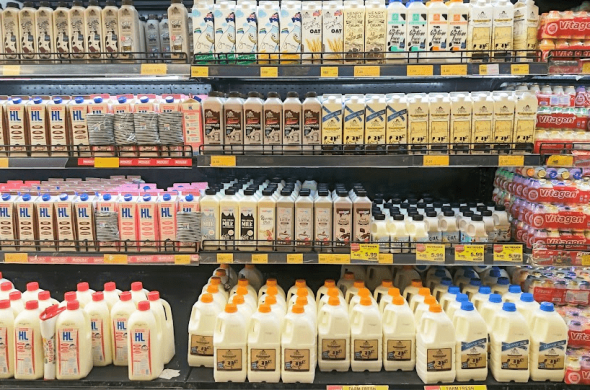The food and beverage industry is constantly evolving due to many factors. While this is happening to meet the requirements and demands of modern-day consumers, the pandemic has had a lot of influence on consumer behavior.
Following the trends we highlighted for the food & beverage industry during 2021, more and more people are becoming more cautious about what they eat and drink. These trends have led to a rise in the popularity of organic and sustainable food options and more environmentally-friendly packaging. In this article, we’ll look at the eight key trends and beverages industry trends for 2022.
Sugar reduction
Consumers are increasingly looking to reduce their sugar intake as concerns over the health effects of sugar continue to grow. This is causing a shift toward more low- and no-sugar foods and beverages and a rise in sugar-free alternatives.
According to a survey by the International Food Information Council Foundation, 74% of Americans are trying to limit their sugar intake because they believe it is unhealthy. As a result, sugar-free products are also becoming increasingly popular, as they offer consumers the opportunity to reduce their overall caloric intake without sacrificing taste or quality.
Home cooking
Home cooking will likely remain a popular trend in 2022 because it is more affordable and easier than eating out. In addition, home cooking allows consumers to control the ingredients they use, which can benefit their health.
In addition, home cooking is also becoming more convenient. With the rise of mobile apps and online resources, it’s easier than ever before for people to cook at home. Furthermore, there are now many different kitchen appliances that make home cooking easier and more convenient.
For example, kitchen automation and tech appliances can do tasks typically done by humans, such as slicing and dicing vegetables. We believe this is likely to continue in 2022 because manufacturers will continue to develop new technologies that make cooking at home easier and more convenient.
Indulgence in food and drinks will continue
In 2022, the indulgence will continue to be a key trend. As a result, high-calorie, high-fat foods, and beverages will become more popular-as well as demand for luxury goods is rising. In particular, chocolate, ice cream, alcohol, and other sweet treats will remain popular.
As consumers become more stressed, they look for ways to let go and enjoy themselves. On the other hand, the increasing popularity of healthy lifestyles will increase demand for beverages and food low in calories and fat.
Functional foods
Functional foods provide health benefits beyond basic nutrition. They can include probiotic yogurt, omega-3 eggs, fruits, vegetables, and seeds.
Functional foods have been around for centuries, but they have become more prevalent in recent years. There are 3 reasons for this:
- People are becoming more aware of the importance of healthy eating habits
- The food industry is increasing its focus on sustainable practices and improving the quality of its products
- Growing consumer demand for healthier options that provide real benefits for their health
In terms of the market, there is a lot of potential for functional foods. It is projected that the global functional food market will reach $275.77 Billion by 2025. This represents a growth rate of 7.9% over the next three years. The main drivers of this growth are increasing consumer demand for healthier options and growing awareness of the importance of functional foods.
Artificial intelligence
With the current advancements in the tech industry, AI will play a significant role in the food and beverage industry in 2022 and coming years. Using AI, restaurants can improve product development, packaging, marketing, and customer service. For example, machine learning can help develop new recipes, create customized packaging, and recommend new products that are more specific to target customers and market.
Plant-based meat
The plant-based meat industry is booming, and it’s not hard to see why. With concerns over the environmental impact of meat production and the health risks of eating meat, more and more people are turning to plant-based meat as a healthier, more sustainable alternative.
The meat tastes and feels like animal meat but with lower calories, cholesterol, and saturated fat. It also tends to be more environmentally friendly because it requires less land and water to produce. It is projected that the plant-based meat market will grow to $24.8 billion by 2030. This growth is being driven by several factors, including the growing concern over climate change and the health risks associated with meat consumption. Although the plant-based meat industry is still in its early stages, it’s still a key food and beverage trend in 2022.
Labor and supply
Labor is a crucial factor in the food and beverage industry, and its influence is expected to grow in importance over the next few years. Labor shortages are already a problem in some parts of the world, and this will only become more prevalent in the coming years.
To compensate for this shortfall, companies will need to adopt strategies to improve labor productivity and reduce costs. One way to do this is by increasing the use of technology. This will allow companies to increase production without having to hire additional workers.
In addition, companies must focus on improving workplace conditions. For instance, this could include ensuring employees have access to health and safety equipment, training, and good working conditions. Improving these conditions will make the workplace more productive and improve employee morale.
Food safety and traceability
Food safety and traceability are becoming more critical as the world becomes more connected due to the increasing number of food recalls and demand for transparency in the food industry.
Food safety ensures that what you eat is free of harmful contaminants, such as bacteria, viruses, parasites, or chemical substances.
Food traceability is the ability to track a food path from the farm to your plate. This can include tracking where the food was grown, processed, packaged, transported, stored, and prepared.
Food & Beverage Consulting Services
Food and beverage consumption trends will impact your business, so take advantage of them. The good news is that we are here to help you capitalize on the latest technologies, improve your operational efficiency, and implement strategic initiatives.
As a leading food and beverage consulting firm, Ollen Group consultants and a team of experts are highly versed with day-to-day F&B business problems and are up to date with consumer shifts in the Middle East, and the necessary steps needed to find success in the future. We offer turnkey solutions from strategy to execution, as well as design, development, and deployment.
Read our latest insights, ideas, and perspectives that explore the trends shaping the future of business and society. Our consultancy services go hand-in-hand with these insights, confirming our position as industry leaders. Get in touch to find out more about our consulting services and industry expertise.



